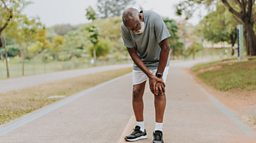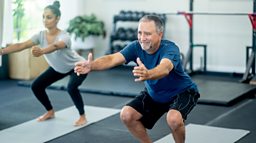How can I look after my knees?
Are you bothered by chronic, low-grade knee pain? Or does it seem to come and go? Do you want to avoid knee pain in the future?
Suffering from knee pain is common, but what can we do to stave off the problems associated with our knees?
In the What’s Up Docs? podcast, twins Chris and Xand van Tulleken look at the largest joint in the human body and ask whether we can do more to care for our knees and reduce chronic pain.
Listen to the knees episode of What's Up Docs?

“In terms of knee pain, we're looking at 15% or so of people getting it in the longer term," says consultant rheumatologist Prof Philip Conaghan. "And of course, it gets more common as we get older.”
Philip Conaghan is a musculoskeletal expert and knows from personal experience how knee pain feels. In the podcast, Philip shares some useful advice for anyone who wants to looks after their knees and help avoid knee pain.
Here are four ways to give your knees the care they need:
1. Identify where the pain is coming from
“Muscles are just lumps of meat, and at each end, they become tendons that stick on to bone, and your kneecap actually sits within the tendon,” says Philip Conaghan. Knee pain can either be caused by a weakening of the muscles and tendons around the knee or emanate from the cartilage or kneecap.
For many of us it’s hard to identify where the pain is coming from. Try quadricep exercises to strengthen your muscles at the front of your thighs. If these help reduce the pain, you can assume the source was your tendons and muscles. If the pain isn’t reduced, it may be caused by an issue with the cartilage or kneecap which will need medical attention.
If the knee is hot, red, swollen or tender this could be because of infection, gout or trauma to the knee. Get advice from your doctor immediately.

2. First get strong, then get fit
If you have trouble getting out of a chair, or the car, it’s time to start strengthening exercises to build up your muscles. Do some non-weight bearing, strengthening exercises which don’t put too much weight on or overload the knee.
If your muscles are strong, you can get more benefit from walking or running and your knees will thank you.
3. Use pain killers sparingly
If you are suffering knee pain, pills can play a role in knee recovery but they won’t address the underlying problem.
Research indicates that non-steroidal anti-inflammatory medication (like over the counter ibuprofen) is much more effective than paracetamol for joint and muscle pain. However, using these long term can have risks associated with them, so Philip Conaghan suggests using the rub-on anti-inflammatory gels, which are safer.
Focus on improving the joint by working on exercises and possible weight loss so you won’t need to rely on painkillers.

4. Get fit and lose weight to stave off having knee replacement surgery
Many people will be so fed up with enduring long-term pain that, with advice from their doctor, they will opt for a knee replacement. According to the National Institute for Health and Care Excellence (NICE), around 100,000 knee replacements are performed in the UK every year. But Philip believes you can delay having to go down this route for as much as five to ten years.
Try losing weight if appropriate, alongside an exercise regime to strengthen your muscles. This may reduce the chronic pain and give you less cause to undergo surgery immediately, but consult your doctor about your plan.
Four exercises to help your knees:
The best thing to do to save your knees is strengthen the muscles which attach to the tendons that surround the knee. Here are some exercises you can try:
1. Walk laps in a swimming pool, because pushing against the resistance of the water will strengthen leg muscles, while also making sure you don’t bear weight through the joint.
2. For a quadricep, thigh-strengthening exercise, lie flat on your back with one leg bent up. To work your other leg, place a rolled up towel behind your knee. Pushing the back of your knee against the towel, lift your heel off the ground and pull your toes back towards your head, making your leg as straight as possible. Hold the leg a few inches above the ground for ten seconds, relax and repeat thirty times if you can. Repeat on the other leg.
3. For the next level up, practise half squats. Lower to a half squat, hold for a few seconds and repeat 30 times if you can. If you have the tolerance, go deeper for more thigh-strengthening.
4. When you’re ready to try the next level, use a bike or cross trainer which won’t overload your knees but will strengthen the leg muscles further.
Listen to the Doctors’ Notes episode for more advice from Prof Philip Conaghan
Try muscle-strengthening exercises to improve other joints too
Many of us get repetitive strain from using a keyboard and mouse all day. Philip says the same rules of muscle strengthening can apply to your hands and elbows too. For hand pain, osteoarthritis and elbow pain, he advises resting your arm on a surface, squeezing a small ball and holding for 30 seconds. Relax for three seconds and repeat this until your arm is tired or aching. Start with 10 repeats and see how you get on. This exercise could mean one less trip to the doctor!
More from What's Up Docs?
-
![]()
How can I look after my knees?
Chris and Xand van Tulleken want to know what, if anything, we should do about knee pain.
-
![]()
Doctors' Notes: Knees
Chris and Xand discuss exercises that can help with chronic knee pain.
-
![]()
Am I hangry?
Can you be hangry? Chris and Xand van Tulleken’s stomachs are rumbling to find out.
-
![]()
How important is willpower?
Can I get better at doing difficult things? Drs Chris and Xand want to know.




